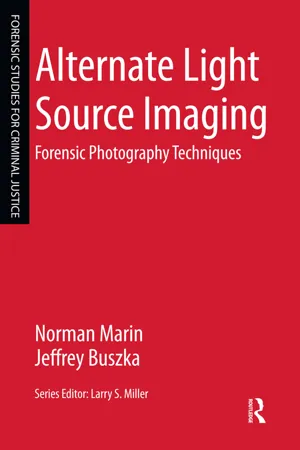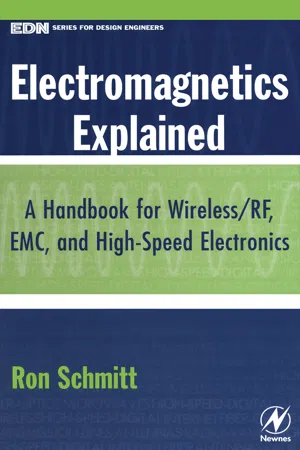Electromagnetic Spectrum
The electromagnetic spectrum refers to the entire range of electromagnetic radiation, including radio waves, microwaves, infrared, visible light, ultraviolet, X-rays, and gamma rays. Each type of radiation has different wavelengths and frequencies, and they are used in various applications such as communication, medical imaging, and spectroscopy. Understanding the electromagnetic spectrum is crucial in studying the interactions of matter with electromagnetic radiation.
6 Key excerpts on "Electromagnetic Spectrum"
- eBook - ePub
Alternate Light Source Imaging
Forensic Photography Techniques
- Norman Marin, Jeffrey Buszka(Authors)
- 2014(Publication Date)
- Routledge(Publisher)
...Furthermore, the absorption of light by a substance may result in fluorescence or phosphorescence, instances where the substance reemits light. When using light to examine physical evidence, it is of course important to understand the nature of light and how it may interact with a substance. With this knowledge, the characteristic properties of a forensic sample can be recognized and documented. In this chapter, the Electromagnetic Spectrum and properties of light will be discussed. 1.1 Light and the Electromagnetic Spectrum Electromagnetic radiation is a radiant energy that exhibits wave-like motion as it travels through space. Everyday examples of electromagnetic radiation include the light from the sun; the energy to cook food in a microwave; X-rays used by doctors to visualize the internal structures of the body; radio waves used to transmit a signal to the television or radio; and the radiant heat from a fireplace. Figure 1.1 The Electromagnetic Spectrum is the distribution of all electromagnetic waves arranged according to frequency and wavelength. Electromagnetic radiation can be divided into several categories that include gamma and X-rays, UV radiation, visible light, IR radiation, thermal radiation, radio waves, and microwaves. When electromagnetic radiation is categorized according to wavelength, it is referred to as the Electromagnetic Spectrum (Figure 1.1). Visible light or white light comprises the individual colors of the rainbow. This is evident when light passes through a prism and is separated into its component colors. The different colors correspond to different wavelengths and frequencies of visible electromagnetic radiation. Red light has a longer wavelength, lower frequency, and lesser energy than blue light...
- eBook - ePub
- John Kenkel(Author)
- 2020(Publication Date)
- CRC Press(Publisher)
...Light waves do not require matter to move or to exist. Rather than being mechanical disturbances, they are electromagnetic disturbances, and as such, they can travel through a vacuum, from the sun to the earth, for example. Since light waves are electromagnetic disturbances, light is often referred to as electromagnetic radiation. It has an electrical component and a magnetic component. Of particular importance in analytical chemistry are the wavelength, frequency, and energy of light as described by the wave theory. Since light consists of a series of repeating waves, the physical distance from a point on one wave to the same point on the next wave is an important parameter. This distance is termed the wavelength. It is given the Greek symbol lower case lambda (λ) (see Figure 6.1). Wavelength can vary from distances as little as fractions of atomic diameters to several miles. This suggests the existence of a very broad spectrum of wavelengths. Indeed, the distinction between visible (vis) light, ultraviolet (UV) light, infrared (IR) light, etc. is the magnitude of the wavelength. Each of these, along with the others mentioned previously, encompass a particular “region” of the total Electromagnetic Spectrum. Thus, we have the vis region, the UV region, the IR region, etc. Figure 6.2 shows a representation of the entire Electromagnetic Spectrum, wavelength increasing left to right, and indicates the approximate wavelength borders of the various regions in nanometers. In the UV, vis, and IR regions, which are the regions that we will be emphasizing, the nanometer (nm) and the micrometer (or micron — μm) are the most commonly used units of wavelength. Another parameter of light derived from the wave theory is frequency. Frequency is defined as the number of waves that pass a fixed point in 1 sec (cycles per second). It is given the Greek symbol nu (v). Frequency would obviously depend on how fast the wave travels...
- Charles Elachi, Jakob J. van Zyl(Authors)
- 2021(Publication Date)
- Wiley(Publisher)
...2 Nature and Properties of Electromagnetic Waves 2.1 Fundamental Properties of Electromagnetic Waves Electromagnetic energy is the means by which information is transmitted from an object to the sensor. Information could be encoded in the frequency content, intensity, or polarization of the electromagnetic wave. The information is propagated by electromagnetic radiation at the velocity of light from the source directly through free space, or indirectly by reflection, scattering, and reradiation to the sensor. The interaction of electromagnetic waves with natural surfaces and atmospheres is strongly dependent on the frequency of the waves. Waves in different spectral bands tend to excite different interaction mechanisms such as electronic, molecular, or conductive mechanisms. 2.1.1 Electromagnetic Spectrum The Electromagnetic Spectrum is divided into a number of spectral regions. For the purpose of this text, we use the classification illustrated in Figure 2.1. The radio band covers the region of wavelengths longer than 10 cm (frequency less than 3 GHz). This region is used by active radio sensors such as imaging radars, altimeters, and sounders, and, to a lesser extent, passive radiometers. The microwave band covers the neighboring region, down to a wavelength of 1 mm (300 GHz frequency). In this region, most of the interactions are governed by molecular rotation, particularly at the shorter wavelengths. This region is mostly used by microwave radiometers/spectrometers and radar systems. The infrared band covers the spectral region from 1 mm to 0.7 μm. This region is sometimes subdivided into subregions called submillimeter, far infrared, thermal infrared, and near infrared. In this region, molecular rotation and vibration play an important role. Imagers, spectrometers, radiometers, polarimeters, and lasers are used in this region for remote sensing...
- eBook - ePub
Electromagnetics Explained
A Handbook for Wireless/ RF, EMC, and High-Speed Electronics
- Ron Schmitt(Author)
- 2002(Publication Date)
- Newnes(Publisher)
...1 INTRODUCTION AND SURVEY OF THE Electromagnetic Spectrum How does electromagnetic theory tie together such broad phenomena as electronics, radio waves, and light? Explaining this question in the context of electronics design is the main goal of this book. The basic philosophy of this book is that by developing an understanding of the fundamental physics, you can develop an intuitive feel for how electromagnetic phenomena occur. Learning the physical foundations serves to build the confidence and skills to tackle real-world problems, whether you are an engineer, technician, or physicist. The many facets of electromagnetics are due to how waves behave at different frequencies and how materials react in different ways to waves of different frequency. Quantum physics states that electromagnetic waves are composed of packets of energy called photons. At higher frequencies each photon has more energy. Photons of infrared, visible light, and higher frequencies have enough energy to affect the vibrational and rotational states of molecules and the electrons in orbit of atoms in the material. Photons of radio waves do not have enough energy to affect the bound electrons in a material. Furthermore, at low frequencies, when the wavelengths of the EM waves are very long compared to the dimensions of the circuits we are using, we can make many approximations leaving out many details. These low-frequency approximations give us the familiar world of basic circuit theory. THE NEED FOR ELECTROMAGNETICS So why would an electrical engineer need to know all this theory? There are many reasons why any and all electrical engineers need to understand electromagnetics...
- eBook - ePub
- Edward M. Robinson(Author)
- 2009(Publication Date)
- Academic Press(Publisher)
...Chapter 7 Ultraviolet, Infrared, and Fluorescence Contents The Electromagnetic Spectrum (EMS) Ultraviolet Light (UV) Infrared Light (IR) on the Electromagnetic Spectrum Visible Light Fluorescence Summary Learning Objectives On completion of this chapter, you will be able to … 1. Explain the various results of light striking different surfaces. 2. Explain where on the Electromagnetic Spectrum the UV range is located. 3. Explain various uses of UV light to visualize otherwise “invisible” evidence. 4. Explain where on the Electromagnetic Spectrum the visible light range is located. 5. Explain the Stokes shift. 6. Explain some of the different types of evidence that can be made to fluoresce so they can more easily be located and collected. 7. Explain where on the Electromagnetic Spectrum the IR wavelengths are located. 8. Explain several types of evidence that can be visualized in the IR range of the Electromagnetic Spectrum. Key Terms Electromagnetic Spectrum Fluorescence Infrared light Luminescence Phosphorescence Photographic infrared range Ultraviolet light Visible light The Electromagnetic Spectrum (EMS) Figure. 7.1 shows the typical wavelength design. The wavelengths of ultraviolet (UV), visible light, and infrared (IR) light are expressed in terms of nanometers (1 nm = one billionth of a meter from peak to peak). Figure 7.1 Wavelength and amplitude. Light on the Electromagnetic Spectrum Other forms of radiation on the Electromagnetic Spectrum include those with much shorter wavelengths (gamma rays and X-rays), as well as those with much longer wavelengths (microwave and radio waves). Most have heard the phrase “the speed of light.” Sometimes this is explained with a reference to lightning...
- eBook - ePub
- Clair Wyatt(Author)
- 2012(Publication Date)
- Academic Press(Publisher)
...They differ in wavelength (frequency and wave number) only. However, the sources that give rise to these radiations and the various types of instruments used to measure them are very different. Figure 2-1 The Electromagnetic Spectrum. (Note: The scale is logarithmic.) The Electromagnetic Spectrum has no definite upper or lower limit. The labeled regions of Fig. 2-1 represent wavelength intervals within which a common body of experimental techniques, such as detection techniques, exist. All such regions overlap. In this book the basic units used are those of the International System (SI) consisting of the meter, kilogram, and second (see Appendix A). However, exception is taken in the case of wavelength and wave number as used to designate the spectrum. The symbol λ is used to designate wavelength which is defined as the distance between two adjacent points in a wave having the same phase. The most common unit for wavelength is the micrometer (μm), where μ is a prefix that represents 10 −6 (see Appendix B for a list of prefixes for use with the SI system). Alternative units for wavelength are the nanometer (nm), where n represents 10 −9, and the angstrom (Å), which is defined as 10 −10 m. The symbol used to represent wave number is, and might be defined as the number of wavelengths that would, at an instant, occupy a space 1 cm in length. The unit for wave number must therefore be reciprocal centimeters (cm −1) where (2-1) with v the frequency in hertz (cycles per second). The spectral ranges considered in this book are categorized on the basis of distinct detection techniques as shown in the accompanying tabulation. Ultraviolet (uv) 1800-4000 Å Visible (vis) 4000-7000 Å Near infrared (NIR) 7000-10,000 Å Short-wave infrared (SWIR) 1-5 μ m Long-wave infrared (LWIR) 5-25 μ m 2-2 INSTRUMENTATION TYPES There are a number of terms used to describe radiometric devices in the literature [ 1 ]...





